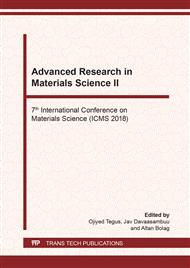[1]
W.P. Hu, Organic Field-Effect Transistors, Science Press, Beijing, (2011).
Google Scholar
[2]
S.R. Forrest, M.E. Thompson, Introduction: Organic Electronics and Optoelectronics, Chem. Rev. 107 (2007) 923-925.
DOI: 10.1021/cr0501590
Google Scholar
[3]
C.D. Dimitrakopoulos, P.R.L. Malenfant, Organic Thin Film Transistors for Large Area Electronics, Adv. Mater. 14 (2002) 99-117.
DOI: 10.1002/1521-4095(20020116)14:2<99::aid-adma99>3.0.co;2-9
Google Scholar
[4]
C.L. Wang, H.L. Dong, W.P. Hu, Y.Q. Liu, D.B. Zhu, Semiconducting π-conjugated Systems in Field-Effect Transistors: A Material Odyssey of Organic Electronics, Chem. Rev. 112 (2012) 2208-2267.
DOI: 10.1021/cr100380z
Google Scholar
[5]
H.L. Dong, X.L. Fu, J. Liu, Z.R. Wang, W.P. Hu. Key points for high-mobility organic field-effect transistors. Adv. Mater. 25 (2013) 6158-6182.
DOI: 10.1002/adma.201302514
Google Scholar
[6]
X.K. Gao, Z. Zhao,High Mobility Organic Semiconductors for Field-Effect Transistors,Sci. China Chem. 58 (2015) 947-968.
DOI: 10.1007/s11426-015-5399-5
Google Scholar
[7]
Y. Yamashita, Organic Semiconductors for Organic Field-Effect Transistors, Sci. Technol. Adv. Mater. 10 (2009) 024313.
Google Scholar
[8]
M.M. Torrent, C. Rovira, Role of Molecular Order and Solid-State Structure in Organic Field-Effect Transistors, Chem. Rev. 111 (2011) 4833-4856.
DOI: 10.1021/cr100142w
Google Scholar
[9]
A. Bolag, M. Mamada, J. Nishida, Y. Yamashita,Field-Effect Transistors Based on Tetraphenyldipyranylidenes and the Sulfur Analogues, Chem. Mater. 21 (2009) 4350-4352.
DOI: 10.1021/cm902037w
Google Scholar
[10]
G.A. Reynolds, C.H. Chen, J.A. Van Allan, J. Org. Chem. 44 (1979) 4456-4458.
Google Scholar
[11]
M.L. Tang, Z. Bao, Halogenated Materials as Organic Semiconductors, Chem. Mater. 23 (2011) 446-455.
Google Scholar
[12]
X.G. Li, Y. Wang, W. Hou, X.M. Zhao, Synthesis and Photoconductive Application of Asymmetric Biphenyl Quinone Electron Transport Materials, Industry of Fine Chemicals 23 (2006) 729-732.
Google Scholar
[13]
M. Mamada, D. Kumaki, J. Nishida, S. Tokito, Y. Yamashita,Novel Semiconducting Quinone for Air-Stable n-Type Organic Field-Effect Transistor, ACS Appl. Mater. Interfaces 2 (2010) 1303-1307.
DOI: 10.1021/am1001794
Google Scholar
[14]
A.S. Hay, Thermolysis of 3,3',5,5'-tetra-phenyldiphenoquinone, J. org. chem. 36 (1971) 218-219.
Google Scholar
[15]
C.D. Dimitrakopoulos P.R.L. Malenfant, Organic Thin Film Transistors for Large Area Electronics, Adv. Mater. 14 (2002) 99-117.
DOI: 10.1002/1521-4095(20020116)14:2<99::aid-adma99>3.0.co;2-9
Google Scholar
[16]
C.M. Cardona, W. Li, A.E. Kaifer, D. Stockdale, G.C. Bazan, Electrochemical Considerations for Determining Absolute Frontier Orbital Energy Levels of Conjugated Polymers for Solar Cell Applications, Adv. Mater. 23 (2011) 2367-2371.
DOI: 10.1002/adma.201004554
Google Scholar


